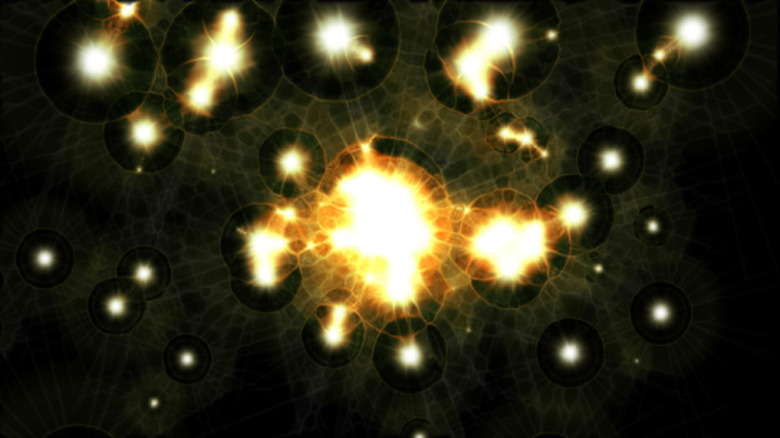What Happens To A Star When It Dies?
The process of a star's dying is like reincarnation. A star never really dies, but rather the material sticks around and creates other formations in space. Astronomers have formed only theories about what eventually happens to stars because the Earth's universe is still very young. One main point of a star's life is to achieve equilibrium, or stability, and once this happens, the star begins to transform once more.
Solar Masses
Solar Masses
If the star is half the mass of the sun, or 0.5 solar masses, the star does not collapse upon itself when it dies. This star transforms into a white dwarf. The process depends on its equilibrium, or when the star is done changing and there is equal gas pressure pushing out from the center to the gravity pulling atoms toward the center. The star then enters an active phase, where hydrogen begins burning into helium. When this is over, the cycle starts over; the original star dies and becomes a white dwarf.
White Dwarf
White Dwarf
The core of a white dwarf star surrounds itself with layers of hydrogen, which still burn, continuing to fuse. The star expands, growing bigger and eventually transforms again to become a red giant. Instead of dying, the process starts over again; only now the white dwarf begins a new life as a red giant.
Red Giant
Red Giant
During a red giant phase, the star fuses the helium from all the burned hydrogen to form carbon and oxygen. However, the star must have sufficient energy, or else its outer shell begins to shed, which leaves behind an inactive core or just molecules of oxygen and carbon. The red giant then goes back to being a white dwarf but only a remnant. The remnant then theoretically becomes a black dwarf; however, this is not scientifically proven yet. If the red giant star has enough energy, then instead of dying, a nebula forms.
Below Chandrasekhar Limit
Below Chandrasekhar Limit
The Chandrasekhar limit is 1.4 times the mass of the sun. If a star reaches its productive phase and is below the Chandrasekhar limit, it becomes a white dwarf. However, if the star is bigger than this limit, a neutron star forms. If the star is more than five times the mass of the sun, then hydrogen burning completely stops, forming a supernova and any other star material forms a black hole.
References
Cite This Article
MLA
Adams, Karen. "What Happens To A Star When It Dies?" sciencing.com, https://www.sciencing.com/happens-star-dies-8144471/. 24 April 2017.
APA
Adams, Karen. (2017, April 24). What Happens To A Star When It Dies?. sciencing.com. Retrieved from https://www.sciencing.com/happens-star-dies-8144471/
Chicago
Adams, Karen. What Happens To A Star When It Dies? last modified March 24, 2022. https://www.sciencing.com/happens-star-dies-8144471/
